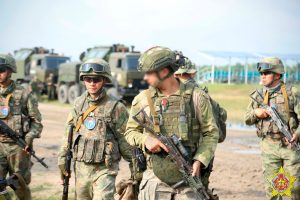The declaration document issued at the recent North Atlantic Treaty Organization (NATO) Summit pronounced the deepening strategic partnership between Russia and China a matter of “profound concern” to NATO members. Further, the declaration referred to China as a “decisive enabler” of Russia’s war in Ukraine, and a systemic challenge to Euro-Atlantic security.
With its external environment becoming increasingly grim and complex, China has chosen to convey its response through force projection. Its ongoing military exercises with Belarus and Russia must be viewed in this context.
On the eve of the NATO Summit, military forces from China and Belarus gathered at a base near Brest city, five kilometers from the latter’s border with Poland, to commence the “Eagle Assault 2024” joint counterterrorism and hostage rescue training exercise. This is the second edition of the exercise, with the first one having been conducted in August 2018 in China’s Jinan city.
In terms of the number of troops participating, the 2024 exercise has put up a larger display of force, with both the People’s Liberation Army (PLA) Northern Theater Command 80th Group Army and the Belarusian Special Operations Forces contributing about 100 troops each. In 2018, the total number of troops deployed by both sides together was 100.
So far, military forces from China and Belarus have engaged in creating an interoperable doctrine on issues ranging from breaking-in doors in a hostage rescue scenario to rappelling from a helicopter in a live-fire situation.
More importantly, however, the goal of the exercise has been to build “mutual trust” between personnel on both sides, and for the PLA to catch up on how to best utilize Belarusian technology and weapons systems. If the idea is for the PLA to adapt and prepare for a realistic possibility of combat in the region, there is no better way than to understand a potential ally’s tactics and technological capabilities.
There is also a symbolic significance to the exercise, which cannot be discounted. Over the past year, various developments have suggested that the Belarus-China partnership, which NATO Secretary-General Jens Stoltenberg recently described as “authoritarian” and “intransparent,” is gaining ground. In 2023, Belarusian President Aleksandr Lukashenko visited China twice and met with President Xi Jinping to develop an “all-weather comprehensive strategic partnership” between their two countries. Subsequently, at the Shanghai Cooperation Organization Summit held on July 4, 2024, Belarus was admitted to the SCO, and another meeting was held between Lukashenko and Xi on the sidelines.
The dates for Eagle Assault 2024, overlapping with the NATO Summit, could have been formalized at any of these high-level exchanges. However, the second edition of this exercise has been pending since 2019, and could have been further delayed, if required. But in China’s view, the timing may have been just right.
China likes to use military exercises as a method to express discontent with concurrent geopolitical events. In May 2022, during the Quad summit in Tokyo, China and Russia conducted a joint bomber sortie near Japan. Similarly, to oppose democratic developments on Taiwan, including the visit of then-U.S. House Speaker Nancy Pelosi to Taipei in August 2022, the PLA has often conducted live-fire and patrol exercises.
In this regard, the ongoing China-Belarus exercise, too, sends a foreboding message to NATO – that if the situation calls for it, the PLA can mobilize kilometers away from its eastern flank.
Concurrently, since July 15, the Chinese and Russian navies have been conducting a three-day maritime exercise in the South China Sea, setting sail from the coast of China’s Guangdong province. The three goals of the exercise are joint reconnaissance and early warning, joint search and rescue, and joint air defense and missile defense. The exercise also has a live-fire element, upping the stakes in the regional security dynamics.
This exercise, too, sends a message to the United States and its military partners, given that it closely follows the conclusion of the Rim of the Pacific (RIMPAC) exercise. RIMPAC 2024, held between June 27 and July 7, was conducted collaboratively by the navies of 29 countries in the South China Sea and the North Pacific Ocean. Given that any power projection in the South China Sea deeply irks China, it has chosen to partner with Russia and respond with force.
Even though the deepening Belarus-China partnership may be considered in some corridors of the Kremlin as the former chipping away at Russia’s traditional sphere of influence, the China-Russia partnership has become too interdependent to collapse. In this light, both parties have left room for maneuver. For its part, Russia recently signed a mutual defense treaty with North Korea on June 19. The move may have reasons to concern China, but given the China-Russia proximity, its reaction remains muted.
On a broader level, an axis is in the making, where China and Russia are creating space for countries such as Iran, Belarus and North Korea to be heard. As their ties solidify, NATO’s threat perception and preparedness will have to take into account not just China’s enabling role in Russia’s war, but also its preemptive role in integrating with and enhancing military capabilities of other authoritarian stakeholders in the region.

































